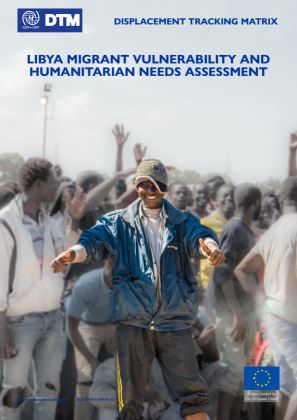-
Countries
-
Data and Analysis
-
Special Focus
-
Crisis Responses
LIBYA - MIGRANT VULNERABILITY AND HUMANITARIAN NEEDS ASSESSMENT

Contacter
DTM Libya, DTMLibya@iom.int
Langue
English
Emplacement
Libya
Snapshot Date
Dec 20 2019
Activité
- Other
- Survey
- Flow Monitoring Survey
This report presents the analysis and findings on the migrant vulnerability and humanitarian needs in Libya, via use of DTM Flow Monitoring Surveys (FMS) and Mobility Tracking Multisectoral Location Assessments (MSLA). The findings are based on 13,228 quantitative interviews conducted via FMS with migrants between January and August 2019, and 2,312 key informant interviews conducted between June – July 2019.
The analysis show that migrants come to Libya from a diverse range of countries of origin, although the majority of migrants present in Libya come from neighboring countries. Migration to Libya is primarily driven by economic motivations that reflect the underlying factors affecting migrants at individual and community levels in their countries of origin such as lack of job opportunities and insufficient income.
Over 80 percent of the migrants interviewed reported that Libya was their intended country of destination at the time of departure from their country of origin, and that they were in Libya for work opportunities. These significant findings strongly indicate that Libya is a country of destination for a majority of migrants, as they seek employment opportunities and better income in Libya than they can access in their countries of origin.
Based on analysis utilizing IOM’s Determinants of Migrant Vulnerability (DoMV) model as an analytical framework gender (female migrants in specific), employment status (unemployment in particular), and duration of stay in Libya (in the case of recent arrivals) were identified as the most significant risk factors adding to the migrants’ vulnerability at the individual level. Female migrants showed higher levels of vulnerability and humanitarian needs across multiple indicators than male migrants. Furthermore, newly arrived migrants in Libya were identified to be in specific need of food and shelter assistance due to lack of access to appropriate accommodation. Meeting these initial needs of the newly arrived vulnerable migrants would significantly reduce their vulnerabilities and address its negative impact on their physical and mental wellbeing. Unemployed migrants in Libya were also found to be more vulnerable and were assessed to have higher humanitarian needs than those employed, indicating reduced capacities to cope. Furthermore, the report also recommends continued advocacy for migrants’ access to public health services, and in the short to medium term direct provision of health services and through referral mechanisms. Lastly, as the desire to return to country of origin is identified as the most significant change in the migration intention, continued attention should be paid to pathways enabling safe return of migrants to their countries of origin.
